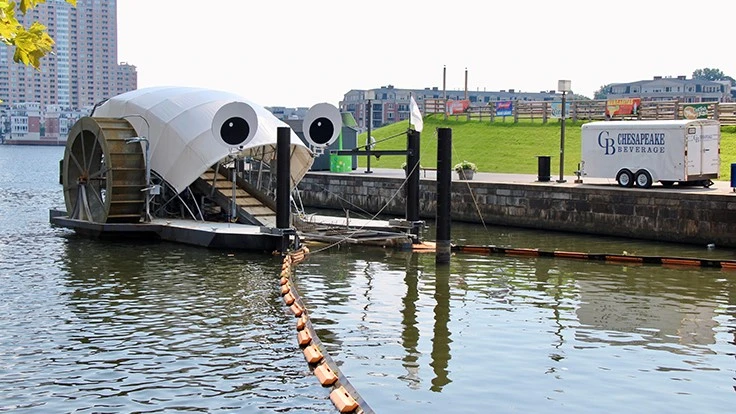
What started as a goal to make the Baltimore Harbor healthy and safe for swimming by 2020 turned into a googly-eyed mascot for clean water and a social media fan base dumpster diving through harbor litter.
In 2008, businesses at the Baltimore Harbor decided a clean harbor would make it a better place to work and visit. They reached out to the Baltimore-based Waterfront Partnership and set a goal to make the harbor safe for swimming and fishing by 2020.
“When you have an aggressive deadline like that it forces you to get creative and try new things,” Adam Lindquist, director of the Waterfront Partnership’s Healthy Harbor Initiative, says.
One of the biggest problems, Lindquist says, is the litter that flows from streets into storm drains and deposits into the harbor. To combat the accumulation of waste in the harbor, the partnership turned to Pasadena, Maryland-based Clearwater Mills, a company that had piloted a small “trash wheel,” a machine that collected waste and debris from the harbor.
“The pilot was ultimately deemed to be too small for the waterway that it was trying to clean up, but the businesses around the waterfront absolutely saw a difference just from that pilot project,” Lindquist says. The partnership approached Clearwater Mills after the pilot with plans to build a bigger, better designed, more permanent trash wheel. Lindquist says that’s when Mr. Trash Wheel was born.
Mr. Trash Wheel is the name of the Inner Harbor Water Wheel Trash Inceptor that has been collecting waste from the harbor since 2014.
Sitting at the end of the Jones Falls stream, Mr. Trash Wheel has collected about 850 tons of waste from the harbor, according to Lindquist.
“It’s not a Roomba—people often think it travels around the harbor looking for trash—it doesn’t,” Lindquist says. “When it rains on that land, rain carries trash off of our parking lots, out of our alleys, into our storm drains, and it all kind of bottlenecks at the end of the Jones Falls stream, which is right here at the inner harbor. We realized that if we put a trash wheel, right there at the end of the stream, that’s kind of your last best place to capture all of the litter and debris coming down that waterway.”
Once the litter is collected, it is taken to shore and transported to Baltimore’s waste-to-energy plant, Lindquist says. Because of the status of sorting technology in Baltimore and the high levels of toxins in the waste picked up by the trash wheel, most of the waste does not get recycled.
Mr. Trash Wheel is more than just a waste collector, though, Lindquist says.
“We thought it was great for picking up trash, but once we saw the online interest, we knew we wanted to grow that into a campaign,” Lindquist says. “So we invented Mr. Trash Wheel, which was the idea of putting googly eyes on the trash wheel and giving it a voice on social media.”
With Mr. Trash Wheel’s social media following, the Waterfront Partnership has been able to assemble large groups of volunteers for rallies and events. One such event is a “dumpster dive,” where people can sign up to sort through harbor waste. This is a rare opportunity to recycle some of what the trash wheel picks up, Lindquist says.
Mr. Trash Wheel’s success led to the installation of Professor Trash Wheel in 2016 and, more recently, Captain Trash Wheel June 5. While the Waterfront Partnership purchased Mr. Trash Wheel and Captain Trash Wheel, the Baltimore-based Maryland Port Administration bought Captain Trash Wheel.
As the trash wheels grow in popularity, Lindquist says the partnership gets weekly emails from around the world with inquiries about trash wheel technology. “It’s only a matter of time before it starts popping up in other places,” Lindquist says.
Lindquist says the most likely contender for the next trash wheel is Honolulu. He says he has given presentations to Toronto, New York City, Milwaukee and Newport Beach, California.
While many places show interest in investing in trash wheel technology, Lindquist says the biggest challenge is disposing of hundreds of dumpsters of collected waste.
Lindquist says the Healthy Harbor Initiative is about “engaging people in the restoration of the harbor,” and Mr. Trash Wheel has put a face to that effort. “He’s really become the mascot now for the restoration of the Baltimore Harbor,” he says. “If you care about clean water in the harbor, you know who Mr. Trash Wheel is, and you follow him on social media.”
Latest from Waste Today
- AED opposes “right to repair” language in federal bill
- UP reaches agreement to acquire Norfolk Southern
- Wisconsin county food scrap program sees success following launch
- Meridian organizes aid for flood victims
- Republic adds electric trucks, new landfill gas projects in 2024
- IEG hires general manager of service
- FZUK announces new commercial director
- Small-scale WTE partnerships





